The Coventry P.E.A.C.E. Campus proposal is rooted in the 100-year history of the property as a center for arts, education and community gatherings.
COVENTRY SCHOOL
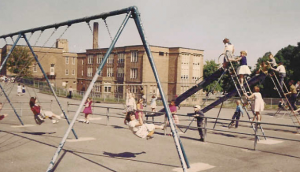 “The original Coventry School [1919-1976] was a wonderful and quite unusual building. Equally distinctive were the two playgrounds: an upper playground bordering Washington Boulevard and a lower playground bordering Euclid Heights Boulevard. A long, curving ramp — perfect for dangerous, high-speed skateboarding — connected the two playgrounds. Of course, the playgrounds themselves were none too safe either, with hard asphalt surfaces everywhere and several high-rise monkey bars, they were in real need of wet pour surfacing.
“The original Coventry School [1919-1976] was a wonderful and quite unusual building. Equally distinctive were the two playgrounds: an upper playground bordering Washington Boulevard and a lower playground bordering Euclid Heights Boulevard. A long, curving ramp — perfect for dangerous, high-speed skateboarding — connected the two playgrounds. Of course, the playgrounds themselves were none too safe either, with hard asphalt surfaces everywhere and several high-rise monkey bars, they were in real need of wet pour surfacing.
Source: ClevelandHistorical.org
“It’s a perennial debate in American education: Do kids learn best when they’re sitting in rows at their desks? Or moving around, exploring on their own? Back in the 1960s and ’70s, that debate led to a brand new school design: Small classrooms were out. Wide-open spaces were in. The Open Education movement was born. Across the U.S., schools were designed and built along these new ideas, with a new approach to the learning that would take place inside them.”
Source: NPR
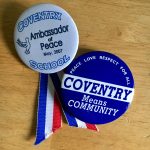 The new Coventry School, built in 1976, adopted “Peace, Love, Respect for All” as its motto. Each month, students who best exemplified that credo were named Peacemakers. Citing declining enrollment, the Board of Education closed the Coventry School in 2007. Following the advice of the Coventry School Study Committee, made up of residents and city officials, the Board of Education began renting space in the Coventry building to non-profit arts and community service organizations.
The new Coventry School, built in 1976, adopted “Peace, Love, Respect for All” as its motto. Each month, students who best exemplified that credo were named Peacemakers. Citing declining enrollment, the Board of Education closed the Coventry School in 2007. Following the advice of the Coventry School Study Committee, made up of residents and city officials, the Board of Education began renting space in the Coventry building to non-profit arts and community service organizations.
COVENTRY P.E.A.C.E. PLAYGROUND
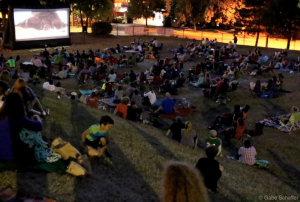
Photo by Gabe Schaffer
“Coventry P.E.A.C.E. Park carries on a piece of the tradition of the closed Coventry School next door. The park originated when neighborhood residents became concerned that the school’s playground had seen better days. In 1991, the Coventry PTA formed a committee that got elementary school students to submit drawings of their ‘dream’ playground.
“The visioning group in the PTA incorporated as Coventry People Enhancing A Child’s Environment, or Coventry P.E.A.C.E., an acronym that evoked the school’s peace theme. Through a series of T-shirt, candy, lemonade, and bake sales, and benefit performances and dinners, the non-profit organization raised nearly $300,000. The park’s construction in October 1993 was in the ‘New England barnraising’ style and proceeded despite torrential downpours.
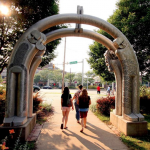
Photo by Gabe Schaffer
“In 2001, the newly formed nonprofit organization Heights Arts sponsored its first public art project in the park: Coventry Arch. Designed by Barry Gunderson, an art professor at Kenyon College, the 180-degree span of aluminum pipes includes four whimsical, abstract figures. Gunderson’s creation, according to his original proposal, is ‘a symbol of greeting, accommodation, and celebration of differences.’”
Source: ClevelandHistorical.org
COVENTRY LIBRARY
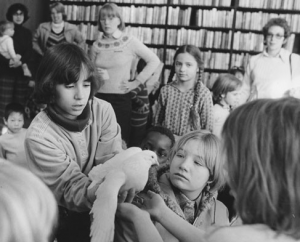 In 1920, Coventry School Library was opened and administered by the Cleveland Heights Board of Education. The following year, the Board of Trustees appointed a librarian, the Cleveland Heights Public Library was organized, and opened to the public. It was housed in the basement of Coventry Elementary School and the school library there became part of it. In 1926, the Main Library was moved from 1916 Lee Road into the new library building at Coventry Road and Washington Boulevard, which was the first permanent building owned by the library.
In 1920, Coventry School Library was opened and administered by the Cleveland Heights Board of Education. The following year, the Board of Trustees appointed a librarian, the Cleveland Heights Public Library was organized, and opened to the public. It was housed in the basement of Coventry Elementary School and the school library there became part of it. In 1926, the Main Library was moved from 1916 Lee Road into the new library building at Coventry Road and Washington Boulevard, which was the first permanent building owned by the library.
Source: HeightsLibrary.org
“A new chapter in the library’s history began with the building’s sale in 1974 to the Fairmount Center for Creative and Performing Arts. The Fairmount Center used the library to provide fine arts services to the CH-UH and East Cleveland school systems, and to run dance programs for Cuyahoga Community College and Lake Erie College. The Fairmount Center leased two main-floor rooms back to the library, so Coventry remained open.
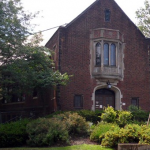 “After an extensive renovation in 1981, Coventry Village Library reopened. Its role as a center for fine arts, however, did not disappear. The Pottery Cooperative of the Heights Guild of Artists and Artisans (later renamed Cleveland Clay Works) purchased ceramic studio equipment, including a kiln, from the Fairmount Center and continued to serve as a pottery-making center. Coventry Village Library has retained its longtime role as a community center, offering musical and theatrical performances (including those for the deaf), poetry readings, and public lectures.”
“After an extensive renovation in 1981, Coventry Village Library reopened. Its role as a center for fine arts, however, did not disappear. The Pottery Cooperative of the Heights Guild of Artists and Artisans (later renamed Cleveland Clay Works) purchased ceramic studio equipment, including a kiln, from the Fairmount Center and continued to serve as a pottery-making center. Coventry Village Library has retained its longtime role as a community center, offering musical and theatrical performances (including those for the deaf), poetry readings, and public lectures.”
Source: ClevelandHistorical.org